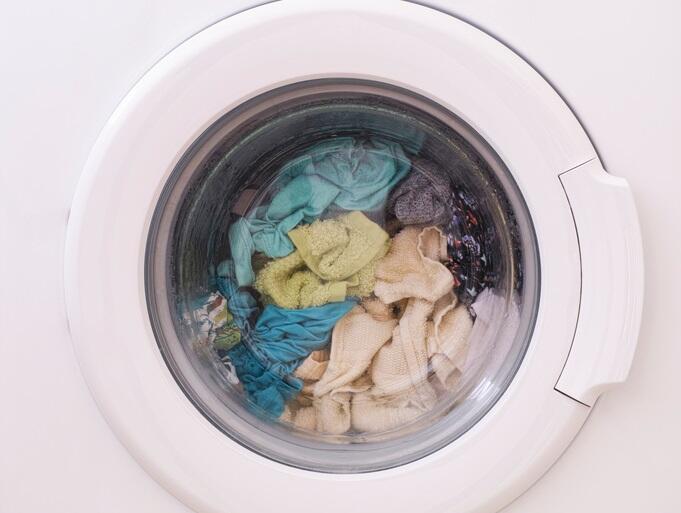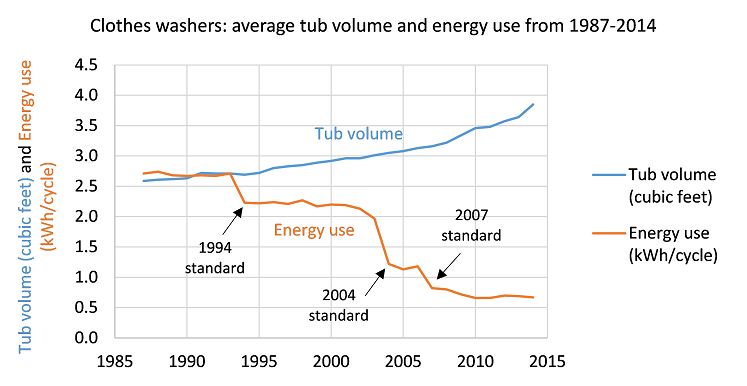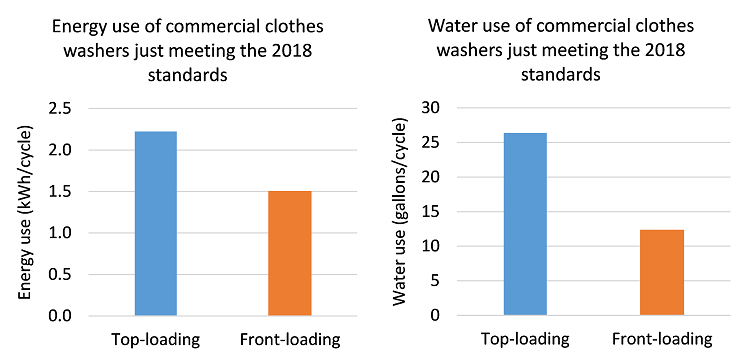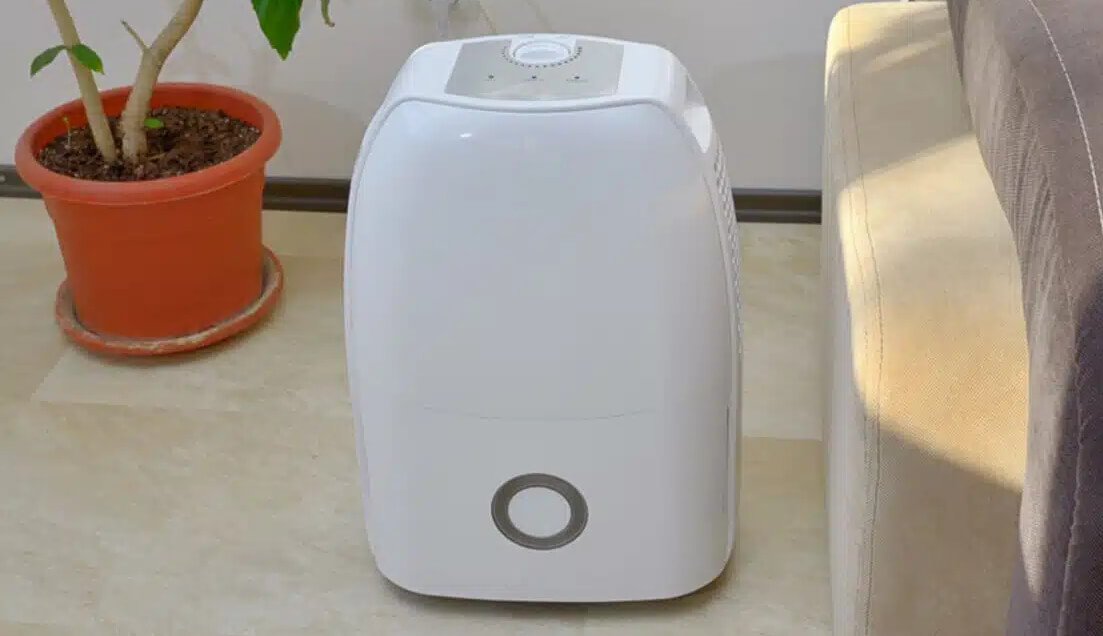
As of January 1, 2018, newly-manufactured clothes washers used in homes, multi-family buildings, and laundromats will be more energy- and water-efficient. For residential washers, the new efficiency standards are the latest in a series of improvements over the last 30 years that have resulted in dramatic decreases in energy and water use. In addition to being more efficient, newer washers are generally bigger, cheaper, and provide better cleaning performance.
Residential clothes washers
The 2018 standards for residential clothes washers are the second tier of standards that were negotiated back in 2010 by manufacturers, efficiency and environmental organizations, and consumer groups. The first tier of standards took effect in 2015. For top-loading washers, the 2015 standards represented energy savings of 26% and water savings of 16% relative to the previous standards. For front-loading washers, the savings were 43% and 52% for energy and water use, respectively.
Top-loaders will see a significant additional efficiency boost with the 2018 standards. Compared to the 2015 standards, the 2018 standards will reduce energy use by 18% and water use by 23%. The standards for front-loading washers, which are generally more efficient than top-loading models, remain unchanged in 2018.
DOE estimated that the 2015 and 2018 standards combined will save 3 trillion gallons of water over 30 years, eliminate the need for 1.3 gigawatts (GW) of electricity generating capacity (or roughly the output of two average-sized coal plants), and net consumers up to $30 billion in savings.
Since 1987, when Congress established the first national standards for residential clothes washers, clothes washer energy use has decreased substantially: an average new washer in 2014 used 75% less energy than one in 1987. This dramatic decline in energy use occurred even as washers got bigger: the average tub volume of new washers increased by almost 50% between 1987 and 2014.

Source: Association of Home Appliance Manufacturers.
The standards for clothes washers have also resulted in huge reductions in water use. In the 1990s, typical washers used more than 40 gallons of water to do a load of laundry. New washers just meeting the 2018 standards use less than half that amount, and Consumer Reports has found that the most efficient washers use less than 10 gallons a load.
Clothes washers meeting the new standards provide not only significant energy and water bill savings, but also better cleaning performance and more features than older washers. Unlike traditional top-loading washers, high-efficiency (or “HE”) top-loaders don’t have a center agitator. According to Consumer Reports, most high-efficiency top-loaders “are better at cleaning, gentler on fabrics, quieter, and use less water” than older washers. And front-loaders provide even better performance than high-efficiency top-loaders. Consumers also now have a wide range of new features available to them such as large-capacity tubs, automatic dispensers, and electronic displays.
While clothes washer energy and water use have declined, washers have also gotten cheaper. In our 2013 report, Better Appliances, we found that between 1987 and 2010, real prices of clothes washers declined by 45%. A 2017 paper similarly found that holding quality constant, between 2002 and 2011, during which three new standards took effect, clothes washer prices decreased by more than $400.
The history of standards for clothes washers has provided both huge savings for consumers as well as predictability for manufacturers. The standards that took effect in the 2000s were also based on a consensus agreement between manufacturers and efficiency advocates and, similar to the 2015/2018 standards, included two tiers (with standards taking effect in 2004 and 2007). The implementation of the 2018 standards is the latest step in a sequence of predictable changes to the standards over the last two decades that manufacturers have been able to plan for. This predictability allows manufacturers to transition to producing more-efficient products while continuing to provide increased consumer value.
Commercial clothes washers
New standards are also taking effect for commercial clothes washers, which are typically used in multi-family buildings and laundromats. The new standards will reduce the energy use of top-loading and front-loading commercial clothes washers by 15% and 18%, respectively. The standards will also cut the water consumption of front-loaders by 20%, while the water use of top-loaders will remain essentially unchanged.
The standards for commercial clothes washers are significantly less stringent for top-loading washers than for front-loading machines. While the efficiency of both types of machines will improve with the 2018 standards, significantly greater savings could be achieved if all commercial clothes washers met the efficiency levels of front-loaders. Under the new standards, a top-loading washer can consume almost 50% more energy and more than twice as much water as a front-loading washer of the same capacity.

Note: Assuming a washer capacity of 3.0 cubic feet.
More savings are possible, but updates to standards put on hold
While there has been tremendous progress in improving clothes washer efficiency, additional opportunities remain to reduce energy and water waste and save consumers money. In our 2016 report, Next Generation Standards, we found that updates to the standards for residential and commercial clothes washers could save consumers $2.2 billion and $77 million, respectively, on their annual utility bills by 2035.
DOE is required by law to review standards every six years and determine whether updates are warranted. For residential clothes washers, DOE must publish either a proposed rule or a determination not to amend the standards by May 2018. If DOE issues a proposed rule, the final rule would be due two years later. Any amended standards would not take effect before 2024. (For commercial clothes washers, the deadline for either a proposed rule or negative determination is December 2020.) However, in the recent Fall 2017 Unified Agenda of Regulatory and Deregulatory Actions, DOE indefinitely deferred action on 20 appliance standards, including residential clothes washers.
If DOE does not fulfill their statutory obligation to update standards for clothes washers, they will not only be failing to comply with the law, but also failing to deliver additional achievable energy and water savings for the nation and utility bill savings for consumers.





